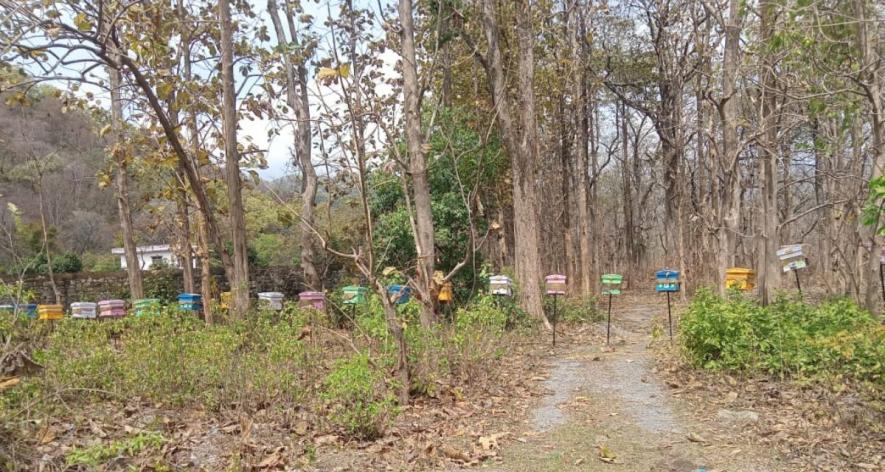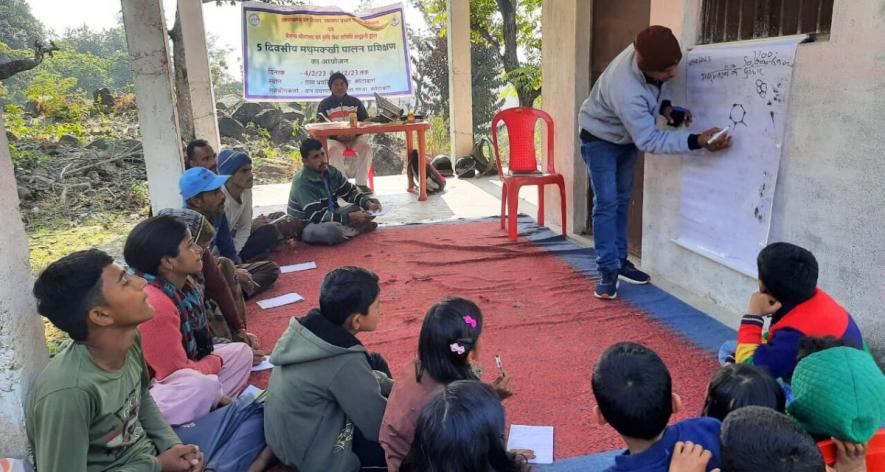Be(e) positive: Uttarakhand looks at Tiny Solution to Tackle Jumbo Problem

A beehive fence in Chausala, in Fatehpur range of Ramnagar division, Uttarakhand
Nainital (Uttarakhand): Last month has been tough on Hema Jalal (29). She could barely sleep with the wheat crop on four bighas ready for harvest and the threat of marauding wild elephants at its peak.
“They come every second or third night now that the crop has matured. Around eight elephants are in this herd. When we hear them arriving, my husband and I vigorously bang tin sheets or flash torchlights. They do run away but only to return soon,” says Jalal, a native of Thapliya Ganja village, in Bhimtal block of Nainital district.
Located about 20 km from the Corbett Tiger Reserve, the village falls under Kaladhungi forest range and abuts an elephant corridor. Rivers Baur and Tilaud flow nearby, which makes the village a conducive spot for elephants.
According to Jalal, the herd that feasts on her crop settled near the village two-and-a-half years ago. Before that, only one or two elephants could be spotted. “They enter the field around 12.30 am and stick until 4 am. Despite our best efforts, we lost wheat in, at least, one bigha,” she says.
When elephant sightings were rare, Jalal harvested around 18 quintals of wheat three years ago. Five and three quintals were kept aside for personal consumption and the next cycle of sowing, respectively. The remaining 10 quintals were sold for around Rs 20,000 annually. Since then, the losses have increased considerably—they lose, at least, 3-4 quintals and their income has nearly halved.

Help comes buzzing
Taking note of the farmers’ plight, the Uttarakhand forest department ran a pilot project to fence the village using a string of bee boxes. “The Kaladhungi range, in Ramnagar forest division, is extremely prone to human-elephant conflict. We started working on the beehive bio-fencing pilot last November,” Kundan Kumar, divisional forest officer (DFO), Ramnagar division, tells 101Reporters.
This unique fence has so far covered a distance of one-and-a half km on the boundary of the reserve forest and revenue land. The boxes are installed in a pattern with an alternating distance of 3 metre and 7 metre between them. Altogether, 60 boxes have been put in place.
Camera traps were installed to assess the outcome. “The bee boxes are linked to each other with wires for fencing. CCTV footage shows that jumbos are indeed scared of honey bees. They just back off the moment they hear bees buzzing,” says Kumar.
An elephant's body is mostly covered with thick skin, but there are soft and sensitive areas, like trunk, ears and feet, where bees could sting.
Though the bee boxes were set up in February, farmers could not take advantage of the pilot this Rabi season. “Our village is surrounded by forest on all sides. Now, elephants are not entering from the side secured using the bio-fence. However, it covers only 40% of the village limits. Therefore, jumbos enter through the porous areas,” explains Dhan Singh Bisht (32), sarpanch, Thapliya Ganja Van Panchayat.
According to him, the 7 metre distance between the boxes should be reduced. “We did not have enough boxes to keep the hives closer. We need more bee boxes and further steps to fence the border.” To this, Kumar says the project extension will be based on the result of the experiment.
Van Panchayat’s crucial role
The forest department involved the community to ensure the project’s success. “The responsibility of fence maintenance was assigned to the Van Panchayat. We trained Panchayat members and women in beekeeping with the help of Haldwani-based NGO Chaitanya Maunalaya Evam Krishi Sewa Samiti. Forty boxes with bees and 20 empty units that the new queen bees searching for hives could utilise were provided,” informs Kumar. So far, 18 villagers have received training.
The Van Panchayat has appointed a watchman for fence maintenance throughout the day for a monthly salary of Rs 6,000. Jamman Singh Bisht, the watchman, is assisted by the van sarpanch or villagers.
“Rosewood, sal and other trees in the forest are in bloom. Litchi plants, which strongly attract honey bees, also blossom now. Many times, bees leave the boxes in swarms and settle on trees. I have to bring them then back using a waxed frame. Once they settle, I place the frame in one of the empty boxes,” the watchman says.
He adds that the bees have enough food around them now in spring but must be fed a solution of sugar or jaggery in the rainy season. Honey is produced in the hives every 45 days depending on the season.
Traditionally, Uttarakhand’s Van Panchayats do water conservation and land management to improve forest habitat. The department hires villagers to work inside the forest. However, they are not paid for beekeeping in Thapliya Ganja.
Villagers are still enthusiastic as the project would save their crops from rampaging jumbos and enhance the Van Panchayat’s income by selling honey, wax and pollen. “A box can provide 15 kg-25 kg of honey. Bees might have eaten some of the produce in the recent rainy days. As the production is based on the types of flowers they feed on, we go by a modest estimate of 5 kg per box,” says sarpanch Bisht.

The Van Panchayat will sell the honey output to Chaitanya Samiti for Rs 400-Rs 500 per kg. They are awaiting the delivery of a honey extractor and a fumigation machine—it will distract bees while removing the honeycomb—from the forest department.
“The income from sales will be primarily used for paying the watchman’s salary. The rest will go into installing new boxes and arranging food for bees,” the sarpanch says. He is happy that honey bees have made new homes in 15 of the 20 empty boxes.
Experimental phase
Human-animal conflicts killed 533 people in 2021-22, according to a reply given in the Lok Sabha on July 25 last year. During the same period, 65 jumbos were electrocuted in 12 states. According to the Uttarakhand forest department, four elephants were electrocuted in the last five years in Kaladhungi range, but there were no human casualties. At least, 48 cases of crop damage were registered.
Several measures have been adopted to stop jumbos in their natural habitats, including making water and fodder available inside forests, and managing pastures and wild bushes. In Uttarakhand, elephant-proof trenches, solar/electric fencing and stone wall have been tried, but none were cheap and thoroughly effective.
“Solar/electric fencing can kill jumbos whereas soil fills up in the trenches during rains. Trenches also promote erosion. In contrast, bees are a natural solution,” explains Kumar. Trenches were tried in Thapliya Ganja and Rishikesh but were not very effective. Besides electric fencing, thorny bushes were used in Haridwar. The same method was adopted in parts of West Bengal, Assam and Tamil Nadu. Chilli cultivation served as a bio-fence in rainfed areas of Karnataka.
As for the beehive bio-fence, there is no definite claim on its functionality in India. However, taking inspiration from a Kenyan project which was 80% successful, the Khadi and Village Industries Commission (KVIC) launched RE-HAB (Reducing Elephant-Human Attacks using Bees) in Karnataka in 2021. It was replicated in nine states, including Uttarakhand.
The forest department is satisfied with the results from such a fence in Chausala in Fatehpur range of Ramnagar division. The KVIC provided 330 bee boxes after the villagers requested in writing. Chaitanya Samiti served as the nodal agency for the project, launched last October.
“CCTV data suggest its effectiveness. One of the captured images showed an elephant near the fence but did not attempt to breach the bee boxes,” Fatehpur Range officer KL Arya told 101Reporters.
The KVIC employs two persons for fence maintenance. It has also trained 33 farmers in beekeeping. On project completion, 10 beehive boxes will be given to each farmer. “This is a yearlong research to understand how beehive fences can prevent man-elephant conflict,” says JS Malik, assistant director, KVIC, Dehradun.
Meanwhile, Chausala village head Bhupal Singh claims that the beehive fence has been effective up to 90%. “Our village is like an island in the middle of a jungle; elephants can come anytime. Ever since the bio-fence was set up, elephant movement has reduced. We saw CCTV footage of elephants breaking two bee boxes but they never took that route again.”
Haridwar had experimented with bio-fence in 2019 itself when Akash Verma was the DFO there. “We used thorny bamboo and lemongrass for about one km each. The bamboo idea succeeded as the jumbo movement in that route stopped. On the flip side, the plant took time to grow and mature. The scent of lemongrass, planted 15 metre to 20 metre apart, did not deter the jumbos,” Verma, now conservator of forests, North Kumaon Circle, told 101Reporters.
According to Malik, bees can boost agricultural production by 30%-35% as they are excellent pollinators. If the fence works, elephants will spare the crops and bees will improve crop yields, thus killing two birds with one stone.
The writer is a Uttarakhand-based journalist and a member of 101Reporters, a pan-India network of grassroots reporters, where this article was originally published.
Get the latest reports & analysis with people's perspective on Protests, movements & deep analytical videos, discussions of the current affairs in your Telegram app. Subscribe to NewsClick's Telegram channel & get Real-Time updates on stories, as they get published on our website.














